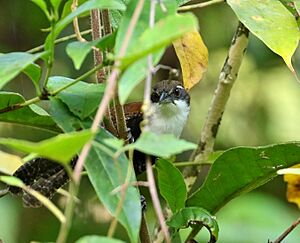Black-bellied wren facts for kids
Quick facts for kids Black-bellied wren |
|
|---|---|
 |
|
| Conservation status | |
| Scientific classification | |
| Genus: |
Pheugopedius
|
| Species: |
fasciatoventris
|
 |
|
| Synonyms | |
|
|
The black-bellied wren (Pheugopedius fasciatoventris) is a small, lively bird that lives in the forests of Central and South America. It belongs to the Troglodytidae family, which includes many types of wrens. You can find this bird in countries like Colombia, Costa Rica, and Panama. It's known for its unique songs and its dark belly.
Contents
What is a Black-bellied Wren?
The black-bellied wren is a type of bird. It is part of a larger group of wrens. Scientists use special names to classify animals. The black-bellied wren has three main types, called subspecies. These are Pheugopedius fasciatoventris fasciatoventris, P. f. melanogaster, and P. f. albigularis. They are all very similar but have small differences.
What Does the Black-bellied Wren Look Like?
Black-bellied wrens are small birds. Male wrens weigh about 23.5 to 34.5 grams. Females are a bit lighter, weighing 19.5 to 28.5 grams. That's about the weight of a few pencils!
All black-bellied wrens have a rich, reddish-brown back. Their tails are also reddish-brown with black stripes. They have a white stripe above their eyes. This stripe is called a supercilium. Their faces are grayish. Their chin, throat, and chest are white. As their name suggests, their belly is black. Two of the subspecies have thin white stripes on their black belly. One subspecies has a plain black belly.
Where Do Black-bellied Wrens Live?
These wrens live in parts of Central and South America.
- One subspecies, P. f. melanogaster, lives in western Costa Rica. It also lives in western Panama, reaching the Canal Zone.
- Another subspecies, P. f. albigularis, is found from the Canal Zone into Colombia.
- The third subspecies, P. f. fasciatoventris, lives in central and northwestern Colombia.
Black-bellied wrens like to live in forests. They can be found deep inside forests or at the edges. They often live near streams. They prefer both old, untouched forests and forests that are growing back.
How Do Black-bellied Wrens Behave?
What Do They Eat?
Black-bellied wrens mostly look for food high up in trees. They search in the top and middle parts of the forest. Sometimes, they also look for food closer to the ground. They always stay hidden in thick plants. These wrens eat small arthropods. Arthropods are creatures like insects and spiders.
How Do They Raise Their Young?
Black-bellied wrens build their nests mostly at the edges of forests. They usually build them close to the ground. Their nests are often hidden in tangled vines. The nests are shaped like a dome with an opening on the side. Both the male and female wrens help build the nest. They use strips of palm and sugar cane leaves. They line the inside with soft plant material.
A female wren usually lays two eggs. It seems that only the female sits on the eggs to keep them warm. Many nests are found and eaten by predators.
What Do Their Songs Sound Like?
Both male and female black-bellied wrens sing a lot. They have many different songs. One male wren was recorded singing 38 different songs! A female wren was recorded with 19 different songs. You can listen to their songs online. Check out Xeno-canto [1] or Cornell's Macaulay Library [2].
What is Their Status?
The IUCN is a group that checks on animals around the world. They have said that the black-bellied wren is of "Least Concern." This means it is not currently in danger of disappearing. However, its numbers are thought to be going down. This is because its home, the forest, is being destroyed or broken up into smaller pieces.
Images for kids



